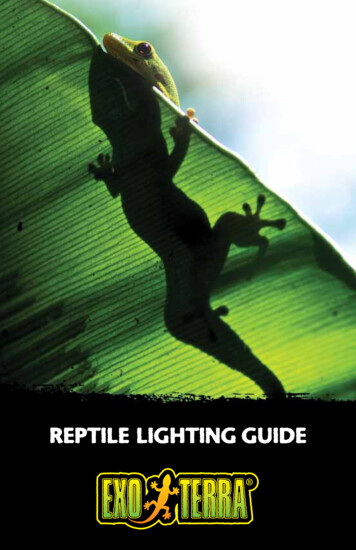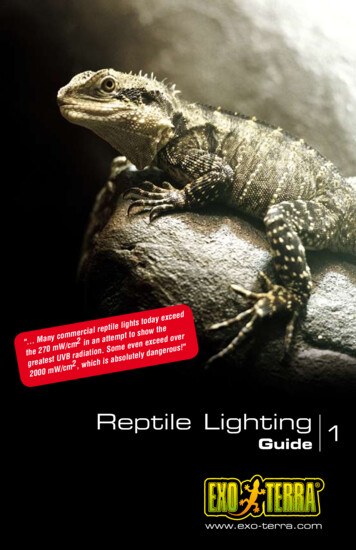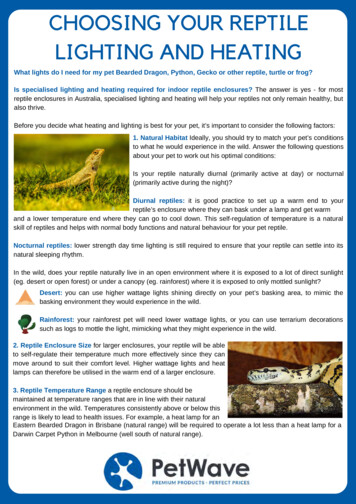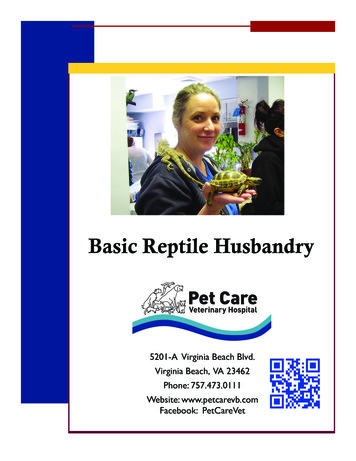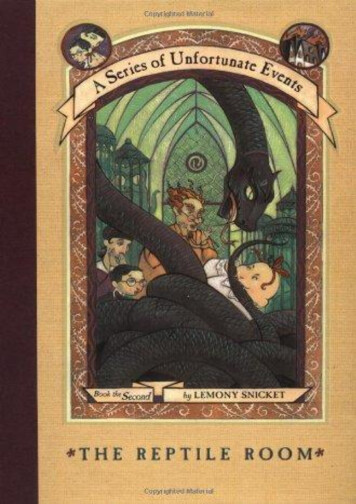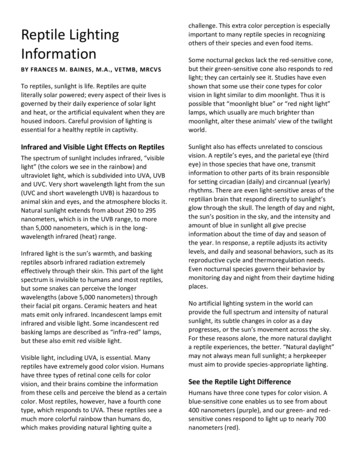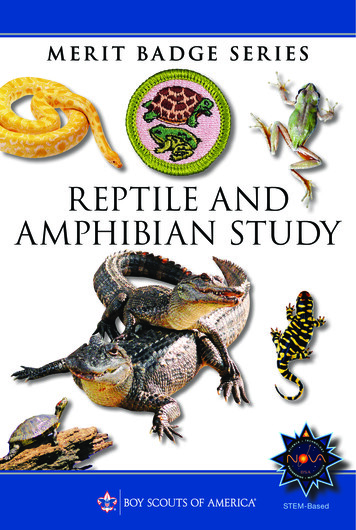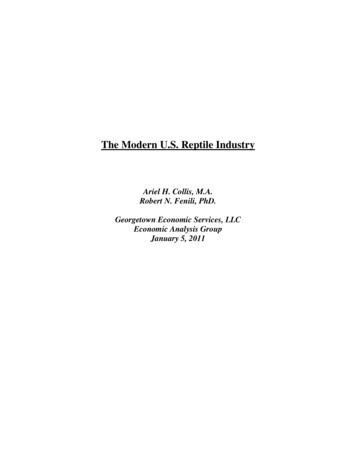
Transcription
The Modern U.S. Reptile IndustryAriel H. Collis, M.A.Robert N. Fenili, PhD.Georgetown Economic Services, LLCEconomic Analysis GroupJanuary 5, 2011
TABLE OF CONTENTSPageEXECUTIVE SUMMARY . 1Overview of the U.S. Reptile Industry. 1History. 1Reptile Laws, Regulations and Proposed New Regulations . 2I.INTRODUCTION . 3The Reptile Narrative: John Till’s Story. 4The Counter-Narrative to the John Till Story. . 7II.PARTICIPANTS IN THE MODERN U.S. REPTILE INDUSTRY. 12Reptile Pet Owners . 12Reptile Suppliers . 15Reptile Breeders . 16Mass Producers . 16Morphs and Large Reptiles . 17Large-scale Breeders . 18Small-scale Breeders . 18International Trade . 20Importers . 21Exporters . 24Wholesalers/Distributors. 27Retailers . 28Pet Superstores . 28Pet Stores . 29Hobbyist Retailers . 30-i-
TABLE OF CONTENTSPageOnline Sellers or E-tailers . 31Summary of Retailers . 31Ancillary Reptile Products and Services. 32Manufacturers . 32Reptile Product Distributors . 34Reptile Delivery Services . 36Reptile Veterinarians . 37Reptile Expos or Trade Shows . 39Other Reptile Organizations . 41Reptile Display Organizations . 41Reptile Entertainment Companies . 43III.TURTLES, LIZARDS, SNAKES. 44Turtles . 45Lizards. 48Snakes . 49Small and Docile . 49Large Constrictors . 50Venomous snakes. 51Snake Morphs . 52IV.CURRENT AND PROPOSED FEDERAL LAWS/REGULATIONS: THEIRIMPACT ON THE REPTILE INDUSTRY . 54The Endangered Species Act (“ESA”). . 55CITIES . 56Impact of CITIES on the Reptile Industry . 58-ii-
TABLE OF CONTENTSPageThe Lacey Act . 58Proposed Rule to List Nine Constrictors as Injurious Wildlife . 59Impact of the Proposed Rule on Imports. . 60Impact of the Proposed Rule on Exports . 62Export substitution Under the Proposed Rule . 64Impact of the Proposed Rule on U.S. Reptile Businesses. 65Prices . 65Holding Costs. 66The Economic Loss to the Reptile Industry of the Proposed Rule . 67Low-Impact Scenario . 68High-Impact Scenario . 69Long-Term Economic Loss . 71V.CONCLUSIONS. 73-iii-
EXECUTIVE SUMMARYThis report provides an overview of the modern U.S. reptile industry. The United StatesAssociation of Reptile Keepers (“USARK”) commissioned this report to shed light on a largelyunstudied sector of the United States economy. The report details the size, scope, and flow oftrade of the reptile industry within the United States. It concludes that the U.S. reptile industry isvibrant and has grown rapidly, but that the industry has been and continues to be impeded byfederal legislation and regulations restricting the import, export, and domestic sale of reptiles.Overview of the U.S. Reptile Industry The U.S. reptile industry encompasses a vast number of participants including petowners, hobbyists, breeders, importers, exporters, wholesalers, pet store proprietors,pet show promoters, entertainers, veterinarians, and manufacturers of pet food andancillary pet products. In 2009 businesses that sell, provide services, and manufacture products for reptilesearned revenues of 1.0 billion to 1.4 billion. In 2009 4.7 million U.S. households owned 13.6 million pet reptiles. Reptileowners are spread throughout the United States without a concentration in any onearea of the country. Reptile businesses can be found throughout the United States although reptileimporters are more densely concentrated in Florida and California than in otherstates. The vast majority of reptile businesses are small, family-run businesses.History The U.S. reptile industry has experienced a significant shift toward domesticcaptive breeding over the past twenty years. Breeders transformed snake husbandry from a hobby to a viable profession by theirsuccessful cultivation of uniquely colored snakes, called morphs.
US turtle farmers were pioneers in the global pet turtle market. U.S. turtle farmerscontinue to lead the world in pet turtle production and sales.Reptile Laws, Regulations and Proposed New Regulations Federal and state regulations and laws concerning reptiles have negatively impactedthe reptile trade within the United States. These laws and regulations have madeselling and shipping reptiles more difficult and more costly. A new regulatory proposal by the U.S. Fish and Wildlife Service to list nineconstrictor snakes as injurious wildlife life under the Lacey Act, however, goesbeyond simple increasing the costs of participants in the retail industry. Theproposal will limit the nearly all sales of the nine constrictors. If enacted, theproposal has the potential to cause deep and lasting damage to the snake market-the very sector of the reptile industry that has helped to drive its growth. If the proposal is enacted: In the short-term, the industry, and snake breeders and sellers in particular, willexperience significant economic losses. We estimate that revenues lost will bebetween 76 million to 104 million in the first year, a loss of 5 to 7 percent of totalindustry revenues. The long-term impact of the proposal on the reptile industry will also be severe. The economic loss to the industry over the first ten years after the proposal’senactment will be between 505 million to 1.2 billion in lost revenues, assuminghistorical industry sales growth. Even assuming no growth, the economic loss over the first ten years after theproposal’s enactment will be between 372 million to 900 million in lost revenues.-2-
I.INTRODUCTIONThe modern U.S. reptile industry is young and has grown rapidly since it came of age inthe 1990s. In less than two decades, it grew from a marginal side business for a few pet stores toa complex industry with annual revenues approaching 1.4 billion. The prime movers fuelingthis growth are small, predominately American businesses.Many of these businesses began as captive breeding operations run by reptile enthusiastsand hobbyists. Over the years, these businesses have expanded their customer base to includeforeign pet owners. In 2009, 11.3 million live reptiles were exported from the United States,while only 900,000 live reptiles were imported into the United States.1 In short, U.S. smallbusinesses dominate the global reptile industry.2As the reptile businesses have grown, so too has reptile ownership. The American PetProducts Association (“APPA”) reports that from 1994 to 2008, the number of U.S. householdsthat own a reptile rose from 2.8 million to 4.7 million, an increase of 68%. In contrast, thenumber of households that own any kind of pet increased only 35% over that same period.The individuals and businesses that comprise the industry have as a common feature theirwonder and appreciation of all living creatures, especially reptiles. In researching this report, we1United States Fish and Wildlife Agency Law Enforcement Management Information System(“LEMIS”) data.2The report was commissioned by The United States Association of Reptile Keepers.-3-
have interviewed many owners of reptile businesses.3 We have found that their lives followed acommon narrative.4 We have summarized this common narrative by creating the John Till story.The Reptile Narrative: John Till’s Story5John Till cannot remember a time when his room was not filled with animals. He wouldspend most of his spare time as a kid trolling the fields and streams that bordered hisneighborhood catching mice, frogs, garter snakes, and turtles. He hung around Selligman’sAquarium with his friends listening to Mr. Selligman hold court, trying to pick up tips onfeeding and reptile and amphibian care. At the age of 13, when the den had been taken over bygarter snakes and salamanders and even the guest room was filling up with turtles, John’s mothergave him an ultimatum – if he caught something and wanted to keep it, he would have to give upan animal in his current collection. His parents were no longer buying him any more animals.When he complained to Mr. Selligman about his mom’s new rule, the pet store ownerlaughed. If John wanted to look after animals, he was more than welcome to feed the animals,sweep up, and clean cages at Selligman’s Aquarium. He would even be paid for his labors.3Information for this report was gathered through a variety of primary and secondary sources. Ourprimary sources include our interactions with reptile breeders and hobbyists at two reptile expositions inSan Diego, California and Daytona, Florida, as well as interviews and surveys of a number of individualsin the reptile trade. For more information on these surveys and survey methodology see Appendix I:Estimation Methodology.4Information for this report was gathered through a variety of primary and secondary sources. Ourprimary sources include our interactions with reptile breeders and hobbyists at two reptile expositions inSan Diego, California and Daytona, Florida, as well as interviews and surveys of a number of individualsin the reptile trade. For more information on these surveys and survey methodology see Appendix I:Estimation Methodology.5The following narrative is a fictionalized composite of several of the life stories of reptilebreeders operating in the United States.-4-
By his fifteenth birthday, John was practically running Selligman’s Aquarium. And heno longer just used nets to gather new reptiles as pets. He would import snakes and lizards fromSouth America and Africa. Often, his father would often drive John to the airport to inspect andaccept delivery of an insulated fifty pound box packed with neatly stacked containers. In eachcontainer was an iguana or a baby Boa constrictor. While most kids his age were working hardat mastering video games, John was learning import regulations.When he was 16, John traveled with Mr. Selligman to Orlando, Florida to attend his firstreptile trade show. To John, it was a revelation. Breeders stood behind tables covered withplastic containers filled with snakes, lizards, and turtles. All of the reptiles had such brightcolors and unique markings that they looked like works of art. Each table was thronged byreptile enthusiasts, cash in hand. The best breeders were spoken of in reverent tones. Everybreeder was accessible and willing to trade tips and give breeding advice. That was the life Johnwanted. He had found his calling. He wanted to be a snake breeder.When he returned home, John read everything he could about snake breeding, justwaiting for the National Breeders Expo to come around again. At the next year’s show hebought some fantastically colored baby Boa constrictors and planned his breeding with theprecision of a scientist. After four years, he sold enough snakes to recover his initial investment.Every year after that, John’s business expanded. Pet stores, wholesalers, and other enthusiasts(who John counted as his friends) were eager to purchase each newly patterned Boa that he bred.Just as some people want to collect and trade Picasso paintings, John’s customers wanted snakes.Some of his customers saw snakes as a good investment, some just wanted them for theircollections, and some wanted them to trade. John knew that a good collectible is something onecan enjoy, but could also trade if the offer is right.-5-
It looked as if John’s business would keep growing forever. At least that is what Johnthought. But in 2008 John’s snake sales came almost to a standstill. People were no longerpurchasing thousand-dollar Boas. Part of the problem was the sinking economy. Part of theproblem was that, at that time, the U.S. federal government was proposing a rule change to theLacey Act that would result in the ban on interstate shipments of Boa constrictors, as well asother constrictor species.6The fear that these constrictors would come under the Lacey Act caused snake prices todrop, because people were selling their snakes cheaply in anticipation of the ban going intoeffect. Boa prices plunged. A Boa that a few years ago would have sold for 1000, suddenlysold for less than 50. Sales were barely enough to cover costs. And those costs, including food,cleaning supplies, utilities, veterinarian services continued unabated. As a result, the industrywas in contraction. John noticed that even some of his suppliers were cutting staff. John thoughtof applying for a desk job and shuttering his breeding business, but he just could not do it. Heloved the snakes too much and had too much invested in his business. The government’s banhad not been enacted yet. Until it did, he just could not give up on his calling.* * *While the story above focuses on one fictional breeder, it is a variation on the story ofmost of the breeders in the reptile industry.7 For example: 6Ralph Davis of Ralph Davis Reptiles: “I was born in 1967 into an animal lovingfamily. By the time I was ten years old, I was completely hooked on reptiles. Iwould go out and collect any kind of herp8 I could find, turtles, lizards and most75 FR 11808; March 12, 2010.7See also, mcreptiles.distortionsleep.net/about.html, royalconstrictordesigns.com/ index.php?page about-us; www.allboas.com/fascination.php; and www.blackpearlreptiles.com.8The term herp is short for herpetofauna. Herpetofauna refer to a category of animals whichincludes reptiles and amphibians.-6-
definitely snakes! My bedroom was full of tanks and makeshift containers for allmy "wild" pets. I worked off and on at the local pet shop for supplies, not money. Iwould also work for animals; at the time, Savannah monitors, skinks, and ballpythons were my favorites.This passion for reptiles lasted into my teens and right into adulthood. I cannotremember as a kid or a teen ever not having a room full of reptiles and it is stillthat way now!”9 Kim Thomas of The Frog Ranch: “Founder Kim Thomas spent the majority of hischildhood growing up in the fields, streams, and ponds of California. He spentnearly every day collecting, keeping and caring for frogs, snakes and any othercreature he was able to catch. In 1968 at the age of 12 he began his "professional"career at a pet store feeding, watering and cleaning cages. Rising every morning at5 a.m. in order to finish in time to get to school, his afternoons were spentdelivering newspapers and then it was off to the fields and creeks until dusk.”10 Kathy Love of CornUtopia: “I've been interested in herps (reptiles & amphibians,collectively) since early childhood. I grew up absorbed with all wildlife, includingearly fascinations with horses, cats & dogs. Being a veterinarian was the firstcareer I ever dreamed of obtaining. I learned about herps through TV, visiting thelocal Milwaukee Zoo and Museum of Natural History, and through books.My first wildlife experiences were with local garter snakes, Thamnophis sirtalis,that neighborhood kids found in wooded lots near my home and used to try to scareme. That sure backfired on them! My initial fears quickly subsided and werereplaced by curiosity as snakes soon became pets, and later a part-time pet business(called "Jungle Hut") in my hometown of Waukesha, Wisconsin, USA.”11Business owners like these, the John and Jane Tills, are responsible for the rise of the UnitedStates reptile industry and for its transformation into the billion dollar industry that it is today.The Counter-Narrative to the John Till Story.Some critics believe that the reptile industry is dominated by unscrupulous individualswho smuggle reptiles into the United States to make easy profits. These critics contend orn%20snakes%20cornsnakes.htm.-7-
retailers knowingly sell these illegally smuggled reptiles to owners who are desperate to ownreptiles as pets and who do not care where the reptiles come from. 12 However a review ofbusiness and trade press about reptile smuggling provide little to substantiate this picture of thereptile industry. The evidence shows that the amount of live reptile smuggling that takes place inthe United States is small. The handful of high-profile cases involving reptile smuggling, whichhave often been repeated in the popular press, took place twenty or more years ago.13Breeders not smugglers form the core of the modern reptile industry. The industry wasbuilt up by innovative, John Till-type breeders such as Bob Clark, Jesse Evans, Bob Applegate,and Mark and Kim Bell, who have pioneered and expanded captive breeding within the UnitedStates. This expansion has resulted in decreased reptile imports and has contributed to the factthat there is very little reptile smuggling in America.U.S. federal government agencies and animal rights organizations often contend thatthere is an extremely large amount of wildlife and reptile smuggling worldwide and in the UnitedStates. For example, a joint September 1998 press release by the Department of Justice (“DOJ”)and the Department of the Interior (“DOI”) states that “According to INTERPOL, the value of12Bryan Christy, in his book on pre-1992 reptile smugglers, The Lizard King, takes this counternarrative picture of reptile owners one step further. He states that “Reptile people are on a trajectory fromthe time that they are children: bigger, meaner, rarer, hot.” (See Bryan Christy, The Lizard King: The TrueCrimes and Passions of the World’s Greatest Reptile Smugglers, 6-7.) Christy’s view is that reptile“people,” after becoming accustomed to small and safe reptiles, soon crave bigger and meaner reptiles.Their cravings lead them rarer reptiles, and, finally, they must have hot (meaning venomous) reptiles. Inshort, turtles and corn snakes are nothing more than the gateway drugs leading owners to collect rarealbino reticulated pythons, and then to seek out highly rare, mean, and venomous snakes such as albinocobras and mambas.If Christy were to be believed, a significant number of the 2.8 million households that ownedreptiles in 1994 for example, would now be cobra and mamba owners as they progress along Christy’sbigger, meaner, and hot continuum. In fact, the number of “mean and hot” snakes owned by Americans isinsignificant. In short, Christy’s thesis is not supported by facts.13See Bryan Christy. The Lizard King.-8-
illegally traded wildlife is approximately 6 billion annually” 14 and that “Reptile smuggling is ahigh-profit criminal enterprise, and the United States is its largest market.”15This lurid description of the reptile industry is not supported by facts. When Bill Clark,an Interpol Secretary was interviewed about the basis for Interpol’s wildlife smuggling estimates,he said, “We have no idea where the media gets its numbers, but it's not from Interpol. Interpol has no reliable data on which to base an estimate.”16Clark’s comments comport withthe statements of Peter Younger, director of Interpol’s wildlife crime division. Younger statesthat, for wildlife smuggling, “Our best guess is anything from 10 to 15 percent of the lawfultrade but it’s only an educated guess.”17 Based on Interpol’s educated guesses, illegal wildlifetrade worldwide is 1 to 3 billion, a figure which is significantly lower than the figures quotedby U.S. government officials.“DOJ, DOI Announce Arrest of Renowned Reptile Smuggler,” September 15, 1998. The DOJrepeats the 6 billion wildlife smuggling claim in an 2000 press release, “Reptile Smuggler Extradited tothe United States from Mexico,” U.S. Department of Justice August 23, 2000.14In 2008, the Congressional Research Service made the claim that “Global trade in illegal wildlife is agrowing illicit economy, estimated to be worth at least 5 billion and potentially in excess of 20 billionannually.” However, the paper concedes that "the illegal trade is difficult to quantify with any accuracy."See Sheikh, Pervaze A. and Liana Sun Wyler. “International Illegal Trade in Wildlife: Threats and U.S.Policy,” Congressional Research Service, Updated August 22, 2008.“DOJ, DOI Announce Arrest of Renowned Reptile Smuggler.” See also U.S. Fish and WildlifeService, “Probe of International Reptile Trade Ends with Key Arrests,” September 15, 1998. The Servicestates in this release that, “Reptiles have become increasingly popular as pets and as high-priced livecollectables. Collectors and breeders are enticed by the lure of the exotic, making rare reptile species anextremely profitable black-market commodity.”15Similarly, in 2007, Joseph O. Johns, the Chief of the Environmental Crimes section in the United Statesattorney’s office in Los Angeles stated that “Wildlife smuggling is the nation’s second-largest blackmarket, just behind narcotics, accounting for 8 billion to 10 billion a year in sales.” Jennifer Steinhauer,“Wildlife Smugglers Test Their Skills, Even at the Airport,” New York Times, April 6, fe.html.Bryan, Christy, “Wildlife Smuggling: Why Does Wildlife Crime Suck,” The Huffington Post,Updated March, 18, 2010 smuggling-why-do english/2008/June/20080616142333 mlenuhre t0.html.-9-8286859.
Evidence indicates that only a small fraction of wildlife smuggling takes place in theUnited States. An even smaller fraction involves smuggling of reptiles into the United States.An analysis of smuggling in the United States was conducted by the U.S. Department ofAgriculture’s Economic Research Service using wildlife trade data for the years 2000-2004.18The USDA report states: “based on fragmentary inspection of the data, wildlife smugglingaccounts for approximately 1 percent of commercial wildlife shipments to the United States.”19According to the report, total earnings from wildlife smuggling in United States amounted toabout 17 million per year for the five-year period, 2000-2004. The report does not disaggregatethe value of shipments by wildlife type, but it does suggest that reptile smuggling is a very minorproportion of the 17 million. It also suggests that reptile smuggling primarily involves shoesand leather products, not live reptiles.20From another perspective, if reptile smuggling were so prevalent in the United States, onewould expect to see numerous accounts of law enforcement activity involving the illegal trade.There are few such accounts. In fact, a review of the Service’s enforcement records for 20062010 list only four cases involving smuggling of reptiles. They are:A reptile smuggler based in Washington State was sent to prison for two years for theunlawful importation of more than 230 reptiles from Thailand; the shipments, valued atover 30,000, entered the United States in falsely labeled express mail packages.18The study was based on an internal U.S. Fish and Wildlife report titled “Illegal Wildlife Trade.”Peyton Ferrier, “The Economics of Agricultural and Wildlife Smuggling,” United States Dept. ofAgriculture, Economic Research Service, no. 81, Note: Ferrier states that the November 2005 U.S. Fishand Wildlife Service internal report reports that : “. . . though enforcement personnel know a great dealabout what illegal trade activities occur locally, there is less understanding of illegal trade activitynationally. . . .”1920Even if one assumes that the USDA estimate is off by a factor of 10, i.e., the USDA understateswildlife smuggling by 90%, even that suggests that total wildlife smuggling into the United States wouldamount to less than 200 million. Even this upper bound estimate hardly supports the oft-heard statementthat the illegal wildlife trade is second in size to only the illegal drug trade.-10-
A Virginia man who pleaded guilty to illegally importing CITES-listed tortoises was fined 15,000.A California man was convicted for his role in an international conspiracy to smugglewild-caught protected Burmese and Indian star tortoises from Singapore for distributionin the United States.A cooperative U.S./Canadian undercover investigation exposed the smuggling ofprotected reptiles from Canada to dealers and collectors in the United States.21The lack of public record of enforcement suggests that reptile smuggling occurs relatively rarelyin the United States.There is no doubt that some reptiles were and still are smuggled into the United States.Any product that is deemed illegal to import will be smuggled into the country if potentialcustomers of the illegal product are willing to pay the costs necessary to induce someone tosmuggle the product into the country. This is true for any product, be it lumber, caviar, orreptiles. However, the evidence suggests that smuggling is not a cornerstone of the reptileindustry as claimed.In addition, over time, the federal government has expanded th
US turtle farmers were pioneers in the global pet turtle market. U.S. turtle farmers continue to lead the world in pet turtle production and sales. Reptile Laws, Regulations and Proposed New Regulations Federal and state regulations and laws concerning reptiles have negatively impacted the reptile trade within the United States.


